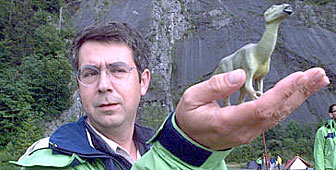Dinosaur discovery rewrites the history books

A sensational dinosaur find on the shores of Lake Lucerne has overturned conventional wisdom about the geology and geography of central Switzerland 110 million years ago.
The 200 dinosaur footprints on a steep limestone rock face near Beckenried in canton Nidwalden date from the Early Cretaceous Period – an age when the whole area was thought to be under water.
“It’s very unusual to find tracks here,” said palaeontologist Christian Meyer, the director of Basel’s natural history museum, who is leading the team investigating the site.
“Until now, most geologists believed that this particular type of limestone rock was formed completely under water so nobody ever thought of looking for dinosaur tracks. Now we can prove that part of this formation was emerged land or at least a shoreline where dinosaurs could walk along and leave their tracks.”
Plant-eating dinosaurs
The tracks, which extend over 30 metres, belong to three plant-eating dinosaurs known as iguanadons.
The footprints show that the creature sometimes moved about on four legs, sometimes on two. From the length of the footprints, Meyer estimates that the iguanadons were between five and seven metres long.
Fossil remains from other sites indicate that the iguanadon lived in herds and studies of dinosaur bones suggest that its lifespan was about 80 to 120 years.
Iguanadons belong to a group of dinosaurs known as ornithopods, which roamed the Earth from approximately 230 million years ago until the mass dinosaur extinction, which took place 65 million years ago.
First tracks from Cretaceous Period
“In addition to being the first tracks in Switzerland from the Cretaceous Period they’re probably the youngest known tracks of iguanadon worldwide,” said Meyer. “Tracks which have been found in England, in northern Germany and also in the USA are a little bit older.”
A geologist from Lucerne, who was climbing in the area, spotted the footprints in the rock face above a disused quarry.
The steepness of the cliff is due to the folding of the Alps some 50 million years ago when tectonic plates collided and masses of rock, several kilometres deep, thrust into and over one another.
“In the near future, we hope to find more sites in the vicinity and also some carnivorous dinosaurs,” said Meyer.
“Then we have to think about where these iguanadons come from because the other known populations were in Belgium, England and France but there are very few bone remains from this period.”
by Vincent Landon

In compliance with the JTI standards
More: SWI swissinfo.ch certified by the Journalism Trust Initiative
You can find an overview of ongoing debates with our journalists here. Please join us!
If you want to start a conversation about a topic raised in this article or want to report factual errors, email us at english@swissinfo.ch.